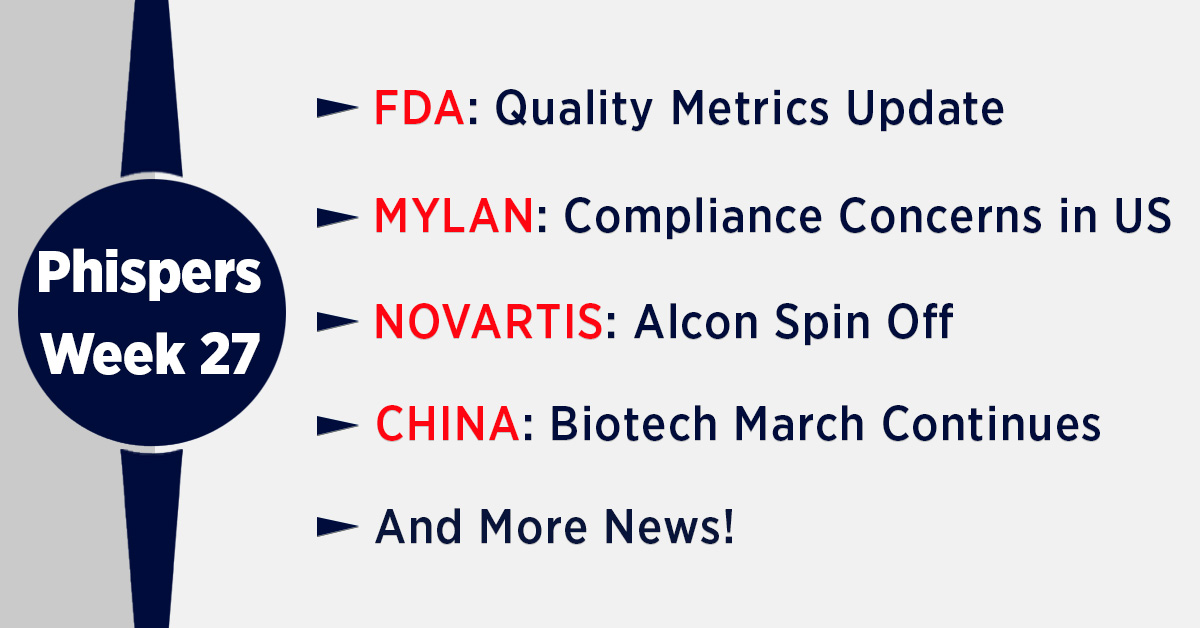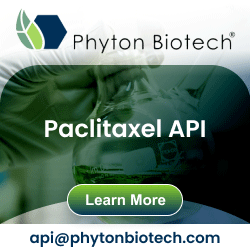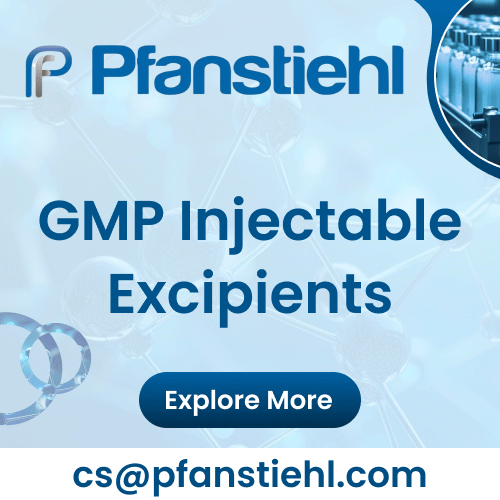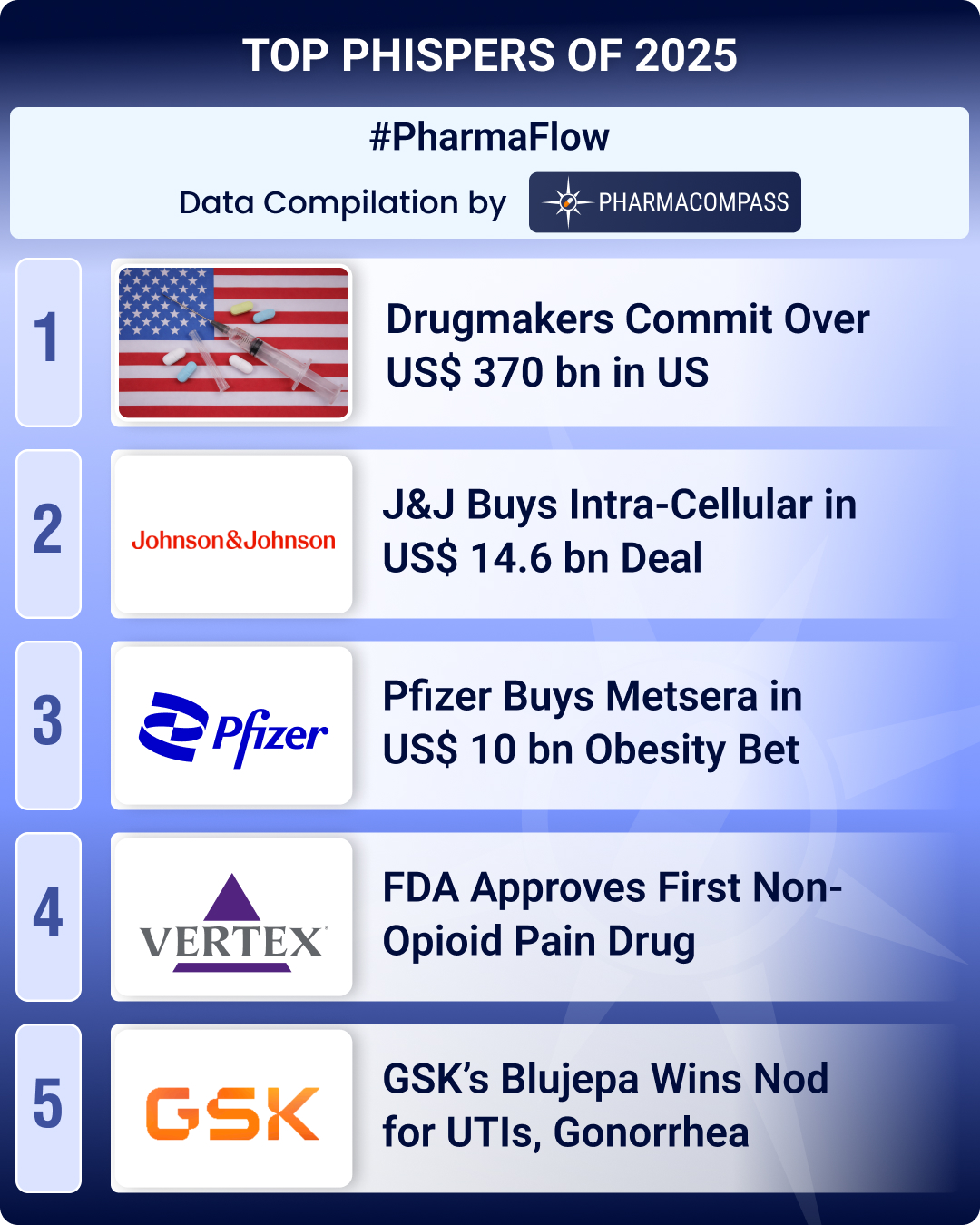
By PharmaCompass
2018-07-05
Impressions: 2134
This week in Phispers, we look at how Novartis is sharpening its focus on developing cutting edge medicines. After buying AveXis in April, this week Novartis decided to spin off eye-care unit Alcon to its shareholders. The fears of pharmacy benefit managers and insurance companies in the US came true as online retail giant Amazon bought online pharmacy PillPack. There was more news on China’s biotech industry as I-Mab Biopharma raised its biggest funding of US$ 220 million. In compliance news, FDA issued Form 483 to Mylan’s US plant and India’s Dr. Reddy’s Laboratory recalled its cholesterol drug in the US. Biogen exercised its option to purchase additional shares in Samsung Bioepis. And FDA announced two new programs for quality metrics.
Novartis to
spin off Alcon to its shareholders; Lundbeck gets a new CEO
Novartis’ new CEO Vas Narasimhan has planned the third major transaction in the last six months since he took over the reins, in order to narrow down the Swiss drug maker’s focus on developing cutting-edge medicines. Narasimhan is trying to make Novartis a leader in innovation and the use of technology.
This week, Novartis said it will spin off its eye-care unit — Alcon — which is a sluggish performer. Novartis will spin off the company to its shareholders, and buy back up to US$ 5 billion in stock.
In March this year, GlaxoSmithKline Plc had reached an agreement with Novartis for the buyout of Novartis’ 36.5 percent stake in their consumer healthcare joint venture for US$ 13 billion. And in
April, Novartis had purchased rare-disease drugmaker AveXis for US$ 8.7 billion.
Together, all the three moves highlight Narasimhan’s emphasis on finding and bringing new drugs to market. Novartis is looking to broaden its gene-therapy program, concentrating on cancer, neuroscience and ophthalmology. The company also wants to delve deeper into strategies for targeting disease-related proteins that haven’t been well understood, potentially through collaboration, Narasimhan had said.
Novartis had bought Alcon for US$ 52 billion in 2011. Alcon’s earnings plummeted after the acquisition, and its book value is now around US$ 21.6 billion. Analysts said the unit could be worth between US$ 15 billion and US$ 23 billion.
Lundbeck gets new CEO: Danish pharmaceutical firm Lundbeck has picked Deborah Dunsire as its new CEO after Kåre Schultz, its former CEO, was poached by Teva last year.
Dunsire will take charge at a time when Lundbeck is looking to make up for declining sales of older drugs whose patents have expired.
Schultz had cut costs to turnaround Lundbeck. With the financial turnaround complete, Dunsire will focus more on the drug pipeline, chairman Lars Rasmussen said.
Lundbeck specializes in neurological and psychological diseases such as depression and Alzheimer’s. In fact, Lundbeck has deep experience in Alzheimer’s, with plenty of failures reported in recent years.
China’s biotech march: I-Mab closes biggest funding; Sanofi’s R&D hub in Chengdu
Last week, Phispers had carried news on Nature’s annual index of research centers that gave us an insight into China’s biotech industry. According to the report, China had held the top slot amongst research centers across the world.
This week, there is more good news from China’s biotech. China’s I-Mab Biopharma has raised a massive US$ 220 million in a third-round of fundraising.
The scale of the fundraising tells us how China’s biotech industry has come up in recent years. The country is reportedly conducting more clinical trials than the US and is pushing hard to develop advanced new therapies, including CAR-T.
Shanghai-based I-Mab was created when Third Venture Biopharma merged with Tasgen Biotech last year. I-Mab plans to plow the cash back into its pipeline of preclinical and clinical-stage antibody drugs for cancer and autoimmune disorders. I-Mab had completed a US$ 150 million series B round of fund raising in March 2017.
Meanwhile, Sanofi is launching a global R&D operations hub with specialized focus on digitalization and big data analysis in Chengdu, Sichuan province, China.
The new R&D operations hub confirms China as the third pillar of Sanofi’s Global Clinical Sciences and Operations, with the first two pillars being its facilities in France and the United States.
With an investment of US$ 77 million (€66 million), the hub will support clinical research and the development of Sanofi’s innovative drugs. Bringing together global data and analysis, the Hub will accelerate the availability of trial results, from Phase I to Phase IV.
Compliance recap: FDA’s Form 483 to Mylan’s US plant; DRL recalls cholesterol drug
The US Food and Drug Administration (FDA) has issued a Form 483 to Mylan Pharmaceuticals’ manufacturing facility in Morgantown (West Virginia) in the US.
The FDA investigators noted 13 situations of non-compliance to good manufacturing practices (GMPs) in the 32-page Form 483. FDA has listed out inspectional observations, some of which were due to failures of its quality control unit.
Mylan said it has sent a “comprehensive response” to the FDA and is committed to a robust improvement plan. “We remain confident in the quality, safety and efficacy of our drug products, including those in distribution, and we continue to manufacture and ship product from the site,” the company said.
The 483 cites the quality unit’s failure to “adequately validate the cleaning processes of all manufacturing equipment and utensils shared between [the firm’s] 230 oral dosage drug products (potent and non-potent) to ensure no cross-contamination of active ingredients and detergent occur between products.”
The investigators also point to three instances of poor cleanliness of equipment that had been released by the quality unit.
Meanwhile, Dr. Reddy’s Laboratories is recalling over 236,000 bottles of Atorvastatin Calcium tablets on account of “failed impurities/degradation specifications,” the FDA said in its enforcement report.
Of the total bottles being recalled, 55,126 are of 10 mg strength, 44,894 bottles of 20 mg and 1,30,081 bottles are of 40 mg, it said. The firm is also recalling 6,397 bottles of 80 mg on account of presence of foreign substance. A product complaint was received for a defective tablet with an embedded foreign object found in a bottle, the report said.
Biogen increases stake in Samsung Bioepis
to 49.9 percent
US biotech firm Biogen has exercised its option to purchase additional shares of biopharma developer Samsung Bioepis — a joint venture established in 2012 by Samsung BioLogics and Biogen. Samsung Bioepis is a biosimilar developer.
Biogen will pay Samsung Bioepis US$ 673.4 million to increase its minority stake in the joint venture. Thereby, Biogen will increase its stake in the JV from 5.4 percent to approximately 49.9 percent.
The move was announced by Biogen last week, and is expected to be taken into consideration by the South Korean regulators who are investigating Samsung BioLogics’ bookkeeping in 2015.
“We are very pleased with the progress made to date at Samsung Bioepis and believe exercising this option is an opportunity to create meaningful value for our shareholders,” Biogen CEO Michel Vounatsos said in a statement. “This option allows us to increase our ownership share in a leading biosimilar company at what we believe are attractive terms. We look forward to building an important relationship with Samsung BioLogics.”
In a separate regulatory filing, Samsung BioLogics said the additional shares Biogen would receive by exercising its call option were valued at about US$ 2 billion (2.26 trillion won). In April this year, Biogen had confirmed it will make an additional investment of US$ 370 million (400 billion won) in Samsung Bioepis.
FDA
announces two new programs for quality metrics
Over a decade ago, the FDA had issued a report on Pharmaceutical Quality for the Twenty-First Century.
With time, significant progress was seen towards FDA’s objective of creating a maximally efficient, agile, flexible drug manufacturing sector “that reliably produces high-quality drug products without extensive regulatory oversight.”
In 2015, the FDA had issued a draft guidance, ‘Request for Quality Metrics’, and had sought comments on the same. Since then, the FDA apparently learned that implementing a uniform standard for Quality Metrics across all players in the pharmaceutical industry is not a simple task.
The guidance was revised in November of 2016, and the FDA had indicated that it would make it mandatory for the pharmaceutical industry. The Notice of Availability (NOA) for the revised draft guidance had stated: “After evaluating the results of the voluntary phase of the quality metrics program in 2018, FDA intends to initiate notice and comment rule-making under existing statutory authority to develop a mandatory quality metrics program.”
Post the publication of the revised draft guidance, several industry organizations had said they are opposed to the guidance, including PhRMA, AAM (formerly GPhA) and ISPE. They felt the burden of FDA metrics collection far outweighs its benefits.
Since it posted the revised draft guidance, the agency had been silent on the quality metrics program.
Last week, the FDA put up notices of two new programs — the Quality Metrics Feedback Program and the 2018 Quality Metrics Site Visit Program.
The 2018 Quality Metrics Site Visit Program clearly states that, based on the feedback received from industry (i.e. the Quality Metrics Feedback Program), the FDA staff will need to visit companies to observe their internal practices.
“FDA is proposing this program, in part, in response to input from a variety of stakeholders over the past couple of years,” said the federal notice. The purpose of this program is to “provide experiential and firsthand learning opportunities to FDA staff involved in the development of the FDA Quality Metrics Program and to provide stakeholders with an opportunity to explain the advantages and challenges associated with implementing and managing a robust Quality Metrics Program”.
The notice also invites pharmaceutical companies interested in participating in this program to submit a Quality Metrics Site Visit proposal.
Tech
meets health: Amazon buys PillPack; AbbVie, Google invest further in Calico
In the US, the pharmacy benefit managers (PBMs) and insurance companies have struck several deals in recent months to prepare themselves for an onslaught by online retail giant Amazon.
Amazon’s purchase of online pharmacy PillPack for US$ 1 billion this week rapidly accelerates that threat posed to entrenched retailers, suppliers and middlemen. The move represents a formidable challenge to the two largest pharmacy chains in the US — Walgreens Boots Alliance and CVS Health Corp.
“This provides an avenue for Amazon to disrupt major pharmacy chains the way that they’ve disrupted booksellers, pet supplies, clothing and other big-box retailers,” Lisa Bielamowicz, president of consultancy Gist Healthcare, said.
The Amazon-PillPack transaction is expected to close in the second half of 2018.
According to the US government data, in 2016, Americans spent US$ 328.6 billion on retail prescription drugs. CVS had prescription sales of US$ 59.5 billion last year, while Walgreens sold US$ 57.8 billion worth of drugs in fiscal 2017.
AbbVie-Google: Four years back, AbbVie and Google-backed life sciences company — Calico — had announced a novel R&D collaboration intended to help the two companies discover, develop and bring to market new therapies for patients with age-related diseases.
The US$ 1.5 billion partnership got a new lease of life last week, as both Google and AbbVie decided to pledge US$ 500 million each to keep the alliance going for some more years.
This new deal extends their first pact by three years, with Calico responsible for research and early development until 2022. Calico will take projects through Phase IIa over the next nine years, with an option to manage late-stage efforts and commercialization.
The two companies are touting the advance of more than two dozen late discovery projects, with a special focus on cellular stress.
The PharmaCompass Newsletter – Sign Up, Stay Ahead
Feedback, help us to improve. Click here
Image Credit : #Phisper Infographic by SCORR MARKETING & PharmaCompass is licensed under CC BY 2.0
“ The article is based on the information available in public and which the author believes to be true. The author is not disseminating any information, which the author believes or knows, is confidential or in conflict with the privacy of any person. The views expressed or information supplied through this article is mere opinion and observation of the author. The author does not intend to defame, insult or, cause loss or damage to anyone, in any manner, through this article.”







